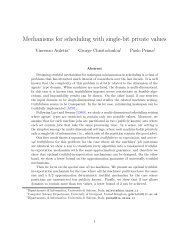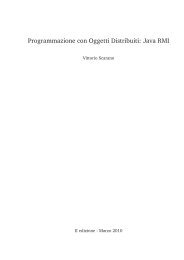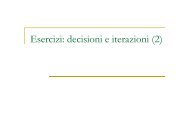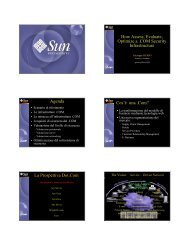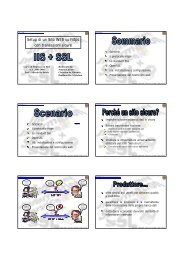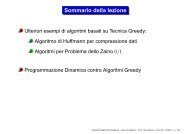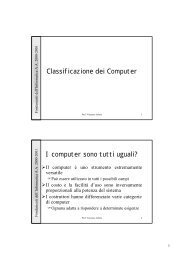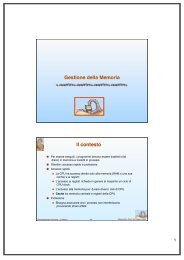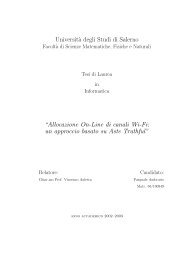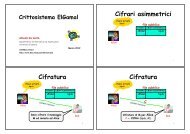Crittografia classica - Dipartimento di Informatica ed Applicazioni
Crittografia classica - Dipartimento di Informatica ed Applicazioni
Crittografia classica - Dipartimento di Informatica ed Applicazioni
You also want an ePaper? Increase the reach of your titles
YUMPU automatically turns print PDFs into web optimized ePapers that Google loves.
<strong>Crittografia</strong> <strong>classica</strong><br />
Alfr<strong>ed</strong>o De Santis<br />
<strong>Dipartimento</strong> <strong>di</strong> <strong>Informatica</strong><br />
Università <strong>di</strong> Salerno<br />
ads@<strong>di</strong>a.unisa.it<br />
http://www.<strong>di</strong>a.unisa.it/professori/ads<br />
Marzo 2012<br />
Steganografia: Esempi<br />
! Erodoto (libro V delle Storie)<br />
! Istieo voleva dare ad Aristagora l'or<strong>di</strong>ne <strong>di</strong><br />
ribellarsi, non aveva alcun altro modo per<br />
annunziarglielo con sicurezza, essendo le<br />
strade sorvegliate, fatta rasare la testa al più<br />
fido degli schiavi, vi impresse dei segni, e<br />
aspettò che ricrescessero i capelli. Non<br />
appena ricrebbero, lo sp<strong>ed</strong>ì a Mileto, non<br />
comandandogli null'altro se non che, quando<br />
giungesse a Mileto, <strong>di</strong>cesse ad Aristagora <strong>di</strong><br />
fargli radere i capelli e <strong>di</strong> guardare la sua<br />
testa: i segni impressi or<strong>di</strong>navano, come già<br />
prima ho detto, la rivolta<br />
Steganografia<br />
Occultamento<br />
del messaggio<br />
Steganografia<br />
Steganos = coperto Grafien = scrittura<br />
Steganografia: Esempi<br />
! Erodoto (libro VII delle Storie)<br />
! Quando Serse ebbe deciso <strong>di</strong> muovere contro la<br />
Grecia, Demarato che si trovava Susa e ne venne<br />
a conoscenza, volle informare gli Spartani. Ma non<br />
aveva altri sistemi per avvisarli, giacchè correva il<br />
rischio <strong>di</strong> essere scoperto, e quin<strong>di</strong> escogitò<br />
questo stratagemma: prese una tavoletta doppia,<br />
ne raschiò via la cera e poi incise sul legno della<br />
tavoletta il piano del re; dopo <strong>di</strong> chè riversò della<br />
cera sullo scritto, affinchè la tavoletta venendo<br />
portata vuota, non procurasse noie a chi la portava<br />
da parte delle guar<strong>di</strong>e delle strade.
Alice<br />
Cifrari simmetrici<br />
Operazioni:<br />
trasposizioni e sostituzioni Trasposizione:<br />
m<br />
canale insicuro<br />
Bob<br />
Tecniche <strong>di</strong> trasposizione<br />
Basate su matrici<br />
EGGSOESIRMGEOAST<br />
m<br />
4 1 3 2 5<br />
M E S S A<br />
G G I O S<br />
E G R E T<br />
O<br />
Cifrari a trasposizione<br />
! Permutazione del testo in chiaro<br />
I simboli del testo in chiaro cambiano posizione<br />
nel testo cifrato<br />
Esempio<br />
! MESSAGGIO SEGRETO<br />
! MSAGOERTESGISGEO<br />
M S A G O E R T<br />
E S G I S G E O<br />
Tecniche <strong>di</strong> trasposizione<br />
Basate su matrici<br />
EGGSOESIRMGEOAST<br />
Ripetizione trasposizione<br />
GSESRAGIOEEGTOMS<br />
4 1 3 2 5<br />
M E S S A<br />
G G I O S<br />
E G R E T<br />
O<br />
4 1 3 2 5<br />
E G G S O<br />
E S I R M<br />
G E O A S<br />
T
Tecniche <strong>di</strong> trasposizione<br />
! Usate da sole sono facili da analizzare<br />
! Le lettere del testo in chiaro sono visibili<br />
! LTEETRE DEL TSETO IN CIHRAO SNOO VSIBILII<br />
! Possono essere usate insieme a tecniche con<br />
sostituzione<br />
Cifrario <strong>di</strong> Cesare<br />
! Proviamolo insieme, collegandoci al link<br />
! http://www.<strong>di</strong>a.unisa.it/professori/masucci/sicurezza0506/<br />
tutorial<br />
! Shift – Cifratura<br />
! Accettare il certificato <strong>di</strong> protezione dell’applet, e poi<br />
Start Applet<br />
! Inserire 3 nella casella Shift<br />
! Per decifrare, scegliere<br />
Shift - Decifratura<br />
Cifrario <strong>di</strong> Cesare<br />
Svetonio (Vitae Caesarorum): lettera <strong>di</strong> Cesare a Cicerone<br />
A B C D E F G H I J K L M N O P Q R S T U V W X Y Z<br />
0 1 2 3 4 5 6 7 8 9 10 11 12 13 14 15 16 17 18 19 20 21 22 23 24 25<br />
testo in chiaro<br />
X ! M+3 mod 26<br />
OMNIA GALLIA EST DIVISA IN PARTES TRES<br />
RPQLD JDOOLD HVW GLYLVD LQ SDUWHV WUHV<br />
testo cifrato<br />
Cifrari con shift<br />
Cifrari con shift<br />
Chiave K<br />
X ! M+K mod 26 K " {0,…,25}<br />
100-44 a.C.<br />
A B C D E F G H I J K L M N O P Q R S T U V W X Y Z<br />
0 1 2 3 4 5 6 7 8 9 10 11 12 13 14 15 16 17 18 19 20 21 22 23 24 25<br />
Quante chiavi sono possibili?
Cifrario con shift<br />
K RX KTSXPBD HIPHTGP<br />
1 SY LUTYQCE IJQIUHQ<br />
2 TZ MVUZRDF JKRJVIR<br />
Crittoanalisi<br />
3 UA NWVASEG KLSKWJS<br />
4 VB OXWBTFH LMTLXKT<br />
5 WC PYXCUGI MNUMYLU<br />
6 XD QZYDVHJ NOVNZMV<br />
7 YE RAZEWIK OPWOANW<br />
8 ZF SBAFXJL PQXPBOX<br />
9 AG TCBGYKM QRYQCPY<br />
10 BH UDCHZLN RSZRDQZ<br />
11 CI VEDIAMO STASERA<br />
12 DJ WFEJBNP TUBTFSB<br />
13 EK XGFKCOQ UVCUGTC<br />
14 FL YHGLDPR VWDVHUD<br />
15 GM ZIHMEQS WXEWIVE<br />
16 HN AJINFRT XYFXJWF<br />
17 IO BKJOGSU YZGYKXG<br />
18 JP CLKPHTV ZAHZLYH<br />
19 KQ DMLQIUW ABIAMZI<br />
20 LR ENMRJVX BCJBNAJ<br />
21 MS FONSKWY CDKCOBK<br />
22 NT GPOTLXZ DELDPCL<br />
23 OU HQPUMYA EFMEQDM<br />
24 PV IRQVNZB FGNFREN<br />
25 QW JSRWOAC GHOGSFO<br />
Crittoanalisi<br />
Dato un testo cifrato<br />
! Provo tutte le possibili chiavi<br />
Facile da fare<br />
! Poco tempo<br />
Una sola chiave mi darà un testo in chiaro con<br />
senso compiuto<br />
! È il messaggio originale<br />
Cifrari a sostituzione<br />
monoalfabetica<br />
Alfabeto in<br />
chiaro<br />
A B C D E F G H I J K L M N O P Q R S T U V W X Y Z<br />
O C T M B W L A K J D X I N E Y S U P F Z R Q H V G<br />
testo in chiaro: C A S A<br />
testo cifrato: T O P O<br />
Numero <strong>di</strong> chiavi da provare: 26! = 4 x 10 26<br />
Con 10 6 computer, ognuno che prova 10 9 chiavi al secondo, la<br />
ricerca esaustiva richi<strong>ed</strong>e 10 4 anni<br />
Improponibile!<br />
Alfabeto<br />
cifrante
Frequenze occorrenze lettere<br />
A B C D E F G H I J K L M N O P Q R S T U V W X Y Z<br />
italiano 10,3 0,9 4,3 3,8 12,6 0,8 2,0 1,1 11,6 0,0 0,0 6,6 2,6 6,6 8,7 3,2 0,6 6,7 6,1 6,1 3,0 1,5 0,0 0,0 0,0 0,9<br />
inglese 7,3 1,3 3,5 4,3 12,8 3,0 2,0 3,5 7,8 0,3 0,5 3,7 2,8 7,8 7,5 2,8 0,5 8,5 6,0 9,3 3,0 1,5 1,5 0,5 2,3 0,3<br />
francese 8,3 1,3 3,3 3,8 17,8 1,3 1,3 1,3 7,3 0,8 0,0 5,8 3,2 7,2 5,7 3,7 1,2 7,3 8,3 7,2 6,3 1,8 0,0 0,0 0,8 0,0<br />
Crittoanalisi<br />
53++!305))6*;4826)4+.)4+);806*;48!8`60))85;]8*:+*8!83(88)5*!; 46(;<br />
88*96*?;8)*+(;485);5*!2:*+(;4956*2(5*-4)8`8*; 4069285);)6 !8)4++;1<br />
(+9;48081;8:8+1;48!85;4)485!528806*81(+9;48;(88;4(+?3 4;48)4+;<br />
161;:188;+?;<br />
caratteri occorrenze<br />
8 33<br />
; 26<br />
4 19<br />
+ ) 16<br />
* 13<br />
5 12<br />
6 11<br />
! 1 8<br />
0 6<br />
9 2 5<br />
: 3 4<br />
? 3<br />
` 2<br />
- . 1<br />
Assumiamo che 8<br />
corrisponda al carattere e<br />
7 occorrenze <strong>di</strong> ;48<br />
Assumiamo che ; ! t<br />
4 ! h<br />
8 ! e<br />
…poi<br />
Crittoanalisi<br />
Edgar Allan Poe, “Lo scarabeo d'oro” (1843)<br />
53++!305))6*;4826)4+.)4+);806*;48!8`60))85;]8*:+*8!83(88)5*!; 46(;<br />
88*96*?;8)*+(;485);5*!2:*+(;4956*2(5*-4)8`8*; 4069285);)6 !8)4++;1<br />
(+9;48081;8:8+1;48!85;4)485!528806*81(+9;48;(88;4(+?3 4;48)4+;<br />
161;:188;+?;<br />
Crittoanalisi<br />
53++!305))6*;4826)4+.)4+);806*;48!8`60))85;]8*:+*8!83(88)5*!; 46(;<br />
88*96*?;8)*+(;485);5*!2:*+(;4956*2(5*-4)8`8*; 4069285);)6 !8)4++;1<br />
(+9;48081;8:8+1;48!85;4)485!528806*81(+9;48;(88;4(+?3 4;48)4+;<br />
161;:188;+?;<br />
5 rappresenta a<br />
! " d<br />
8 " e<br />
3 " g<br />
4 " h<br />
6 " i<br />
* " n<br />
+ " o<br />
( " r<br />
; " t<br />
A good glass in the bishop's hostel in the devil's seat<br />
twenty-one degrees and thirteen minutes northeast<br />
and by north main branch seventh limb east side<br />
shoot from the left eye of the death's-head a bee<br />
line from the tree through the shot fifty feet out.
Few persons can be made to believe<br />
that it is not quite an easy thing to<br />
invent a method of secret writing<br />
which shall baffle investigation.<br />
Yet it may be roundly assert<strong>ed</strong><br />
that human ingenuity cannot<br />
concoct a cipher which human<br />
ingenuity cannor resolve.<br />
Edgar Allan Poe<br />
<strong>Crittografia</strong> Classica<br />
Omofoni<br />
! Molti simboli per cifrare singoli caratteri frequenti<br />
testo in chiaro: E<br />
testo cifrato: Õ Ñ ® (scelti a caso!)<br />
! Si abbassano le frequenze dei simboli del testo cifrato<br />
12.6 per E 3.15 per Õ Ñ ®<br />
28<br />
Nulle<br />
! Aggiungere simboli meno frequenti<br />
! in posizioni da non alterare il significato<br />
testo in chiaro: QUELQRAMODELQLAGO...<br />
testo cifrato: …<br />
Aumento frequenze dei corrispondenti simboli<br />
Nomenclatori<br />
! In aggiunta all’alfabeto cifrante si usa un<br />
insieme <strong>di</strong> parole in co<strong>di</strong>ce<br />
! Svantaggi:<br />
! Compilazione e trasporto del repertorio<br />
! Se cade in mani ostili, ripetizione della<br />
<strong>di</strong>stribuzione<br />
! Non molto più sicuro della singola sostituzione<br />
monoalfabetica
La congiura <strong>di</strong> Babington<br />
! Nel 1586 Maria Stuarda, regina <strong>di</strong> Scozia, fu<br />
condannata a morte per aver cospirato contro la<br />
cugina Elisabetta<br />
! La congiura, organizzata da Anthony<br />
Babington, prev<strong>ed</strong>eva<br />
! La liberazione <strong>di</strong> Maria dalla prigionia in<br />
Inghilterra<br />
! L’uccisione <strong>di</strong> Elisabetta<br />
! Una ribellione alla religione protestante<br />
! Sir Walsingham, segretario <strong>di</strong> stato, provò che Maria<br />
aveva preso parte alla congiura<br />
Oltre la cifratura monoalfabetica<br />
Due approcci:<br />
! Utilizzo <strong>di</strong> cifrature <strong>di</strong> più lettere per volta<br />
! Playfair<br />
! Hill<br />
! Utilizzo <strong>di</strong> più alfabeti cifranti<br />
! Leon Battista Alberti<br />
! Vigenère<br />
La congiura <strong>di</strong> Babington<br />
Maria e Babington comunicavano grazie a<br />
! Un corriere (Gilbert Gifford)<br />
! Un birraio, che nascondeva i messaggi dentro lo zipolo delle<br />
botti <strong>di</strong> birra<br />
! Un cifrario, costituito da<br />
! 23 simboli che sostituivano le lettere<br />
! Un nomenclatore <strong>di</strong> 35 simboli, che sostituivano parole o frasi<br />
! 4 nulle e un simbolo per le doppie<br />
Gifford consegnava a Walsingham tutti i messaggi, che<br />
venivano decifrati da Thomas Phelippes<br />
! Maria firmò la sua condanna a morte rispondendo alla lettera<br />
<strong>di</strong> Babington<br />
! Babington e complici furono arrestati e squartati vivi<br />
! Maria fu decapitata l’8 febbraio 1587<br />
Cifrario <strong>di</strong> Playfair<br />
Cifratura multilettera <strong>di</strong> Playfair<br />
! Cifra due simboli insieme<br />
! Utilizza una matrice 5x5<br />
! Costruita a partire da una parola chiave per<br />
facilità <strong>di</strong> memorizzazione<br />
! I J equivalenti M O N A R<br />
C H Y B D<br />
E F G IJ K<br />
L P Q S T<br />
U V W X Z
Cifrario <strong>di</strong> Playfair<br />
Lettere <strong>di</strong> ogni coppia <strong>di</strong>verse<br />
! Si introduce un simbolo fittizio<br />
! Pallone = pa lx lo ne<br />
Si in<strong>di</strong>viduano le due lettere nella matrice<br />
! Se in<strong>di</strong>viduano un rettangolo<br />
! Ciascuna lettera sostituita dalla lettera che si trova nella<br />
stessa riga del rettangolo<br />
! Se in<strong>di</strong>viduano una colonna<br />
! Ciascuna lettera sostituita dalla seguente nella colonna<br />
! Se in<strong>di</strong>viduano una riga<br />
! Ciascuna lettera sostituita dalla seguente nella riga<br />
Cifrario <strong>di</strong> Playfair<br />
M O N A R<br />
C H Y B D<br />
E F G IJ K<br />
L P Q S T<br />
U V W X Z<br />
M O N A R<br />
C H Y B D<br />
E F G IJ K<br />
L P Q S T<br />
U V W X Z<br />
testo in chiaro: AT TA CX CO<br />
testo cifrato: RS SR<br />
Cifrario <strong>di</strong> Playfair<br />
M O N A R<br />
C H Y B D<br />
E F G IJ K<br />
L P Q S T<br />
U V W X Z<br />
M O N A R<br />
C H Y B D<br />
E F G IJ K<br />
L P Q S T<br />
U V W X Z<br />
testo in chiaro: AT TA CX CO<br />
testo cifrato:<br />
RS<br />
Cifrario <strong>di</strong> Playfair<br />
M O N A R<br />
C H Y B D<br />
E F G IJ K<br />
L P Q S T<br />
U V W X Z<br />
M O N A R<br />
C H Y B D<br />
E F G IJ K<br />
L P Q S T<br />
U V W X Z<br />
testo in chiaro: AT TA CX CO<br />
testo cifrato: RS SR BU HM
Cifrario <strong>di</strong> Playfair<br />
M O N A R<br />
C H Y B D<br />
E F G IJ K<br />
L P Q S T<br />
U V W X Z<br />
M O N A R<br />
C H Y B D<br />
E F G IJ K<br />
L P Q S T<br />
U V W X Z<br />
testo in chiaro: AT TA CX CO<br />
testo cifrato: RS SR BU HM<br />
Cifrario <strong>di</strong> Playfair<br />
! Migliore rispetto alla cifratura<br />
monoalfabetica: 26x26 = 676 <strong>di</strong>grammi<br />
! Ma la struttura del testo rimane!<br />
! Analisi condotta in base alla frequenza<br />
dei <strong>di</strong>grammi più comuni nella lingua<br />
! Italiano: er, es, on, re, en, de, <strong>di</strong>, ti, si, al, ...<br />
Cifrario <strong>di</strong> Playfair<br />
Cifrario <strong>di</strong> Playfair<br />
! Frequenza<br />
<strong>di</strong>grammi inglese<br />
! Esempio: th 315<br />
http://jnicholl.org/Cryptanalysis/Data/DigramFrequencies.php
Cifrario <strong>di</strong> Hill<br />
Cifratura multi-lettera<br />
! m lettere in chiaro successive<br />
! m lettere <strong>di</strong> testo cifrato<br />
! Sostituzione usando algebra lineare<br />
Per m=3 la cifratura delle 3 lettere p 1p 2p 3 è<br />
! c 1 = (k 11p 1 + k 12p 2 + k 13p 3) mod 26<br />
! c 2 = (k 21p 1+ k 22p 2+ k 23p 3) mod 26<br />
! c 3 = (k 31p 1+ k 32p 2+ k 33p 3) mod 26<br />
m=3, primi 3 caratteri<br />
! PAY = (15, 0, 24)<br />
Cifrario <strong>di</strong> Hill<br />
c 1<br />
c 2<br />
c 3<br />
=<br />
17 17 5<br />
21 18 21<br />
2 2 19<br />
! Testo cifrato: (11,13,18) = LNS<br />
Testo cifrato completo: LNSHDLEWMTRW<br />
#<br />
15<br />
0<br />
24<br />
Lester S. Hill, 1929<br />
mod 26<br />
La chiave K è la matrice dei coefficienti k<br />
Es. P = PAYMOREMONEY<br />
Chiave<br />
Cifrario <strong>di</strong> Hill<br />
c 1<br />
c 2<br />
c 3<br />
=<br />
k 11 k 12 k 13<br />
k 12 k 22 k 23<br />
k 13 k 32 k 33<br />
17 17 5<br />
21 18 21<br />
2 2 19<br />
#<br />
p 1<br />
p 2<br />
p 3<br />
Cifrario <strong>di</strong> Hill<br />
mod 26<br />
Per la decifratura si usa la matrice inversa<br />
! Quin<strong>di</strong> K deve essere invertibile<br />
K = K-1 17 17 5<br />
21 18 21<br />
2 2 19<br />
=<br />
p 1<br />
p 2<br />
p 3<br />
=<br />
k’ 11 k’ 12 k’ 13<br />
k’ 12 k’ 22 k’ 23<br />
k’ 13 k’ 32 k’ 33<br />
4 9 15<br />
15 17 6<br />
24 0 17<br />
#<br />
c 1<br />
c 2<br />
c 3<br />
mod 26
Cifrario <strong>di</strong> Hill Cifrario <strong>di</strong> Hill<br />
Come per Playfair la cifratura <strong>di</strong> Hill<br />
! Nasconde le frequenze delle singole lettere<br />
Attacchi possibili<br />
! Se si conoscono m coppie testo in chiaro/cifrato<br />
! Si riesce a recuperare la chiave!<br />
Cifrario <strong>di</strong> Alberti<br />
! Usa più alfabeti cifranti e li<br />
sostituisce durante la cifratura<br />
Leon Battista Alberti, “De Cifris”, 1466<br />
• Era <strong>di</strong>fficile fare i conti a mano<br />
• Costruita macchina per moltiplicazione 6x6<br />
• Sfortunatamente la chiave era fissata per ogni macchina …<br />
• Si suggeriva <strong>di</strong> usare una tripla cifratura seguita da altri passi<br />
• Non ebbe successo commerciale<br />
Cifrario <strong>di</strong> Alberti<br />
! Usa più alfabeti cifranti e li<br />
sostituisce durante la cifratura<br />
I metodo<br />
<strong>di</strong>sco esterno:<br />
<strong>di</strong>sco interno mobile:<br />
Allineare g-A<br />
nulla<br />
ABCDEF GILMNO PQRSTV XZ1234<br />
gklnpr tuz&xy somqih fdbace<br />
LE2ONE<br />
AzpayxpQ<br />
Allineare g-Q
II metodo<br />
Cifrario <strong>di</strong> Alberti<br />
<strong>di</strong>sco esterno:<br />
<strong>di</strong>sco interno mobile:<br />
Allineare g-A<br />
<strong>di</strong>sco esterno:<br />
<strong>di</strong>sco interno mobile:<br />
ABCDEF GILMNO PQRSTV XZ1234<br />
gklnpr tuz&xy somqih fdbace<br />
LEONE3<br />
gzpayxpc<br />
non è una nulla<br />
Allineare c-A<br />
ABCDEF GILMNO PQRSTV XZ1234<br />
cegkln prtuz& xysomq ihfdba<br />
Cifrario <strong>di</strong> Vigenère<br />
A B C D E F G H I J K L M N O P Q R S T U V W X Y Z<br />
B C D E F G H I J K L M N O P Q R S T U V W X Y Z A<br />
C D E F G H I J K L M N O P Q R S T U V W X Y Z A B<br />
D E F G H I J K L M N O P Q R S T U V W X Y Z A B C<br />
E F G H I J K L M N O P Q R S T U V W X Y Z A B C D<br />
F G H I J K L M N O P Q R S T U V W X Y Z A B C D E<br />
G H I J K L M N O P Q R S T U V W X Y Z A B C D E F<br />
H I J K L M N O P Q R S T U V W X Y Z A B C D E F G<br />
I J K L M N O P Q R S T U V W X Y Z A B C D E F G H<br />
J K L M N O P Q R S T U V W X Y Z A B C D E F G H I<br />
K L M N O P Q R S T U V W X Y Z A B C D E F G H I J<br />
L M N O P Q R S T U V W X Y Z A B C D E F G H I J K<br />
M N O P Q R S T U V W X Y Z A B C D E F G H I J K L<br />
N O P Q R S T U V W X Y Z A B C D E F G H I J K L M<br />
O P Q R S T U V W X Y Z A B C D E F G H I J K L M N<br />
P Q R S T U V W X Y Z A B C D E F G H I J K L M N O<br />
Q R S T U V W X Y Z A B C D E F G H I J K L M N O P<br />
R S T U V W X Y Z A B C D E F G H I J K L M N O P Q<br />
S T U V W X Y Z A B C D E F G H I J K L M N O P Q R<br />
T U V W X Y Z A B C D E F G H I J K L M N O P Q R S<br />
U V W X Y Z A B C D E F G H I J K L M N O P Q R S T<br />
V W X Y Z A B C D E F G H I J K L M N O P Q R S T U<br />
W X Y Z A B C D E F G H I J K L M N O P Q R S T U V<br />
X Y Z A B C D E F G H I J K L M N O P Q R S T U V W<br />
Y Z A B C D E F G H I J K L M N O P Q R S T U V W X<br />
Z A B C D E F G H I J K L M N O P Q R S T U V W X Y<br />
Cifrario <strong>di</strong> Vigenère<br />
Blaise de Vigenère, 1586<br />
Cifrario a sostituzione polialfabetica<br />
testo in chiaro<br />
M = M0M1M2…Mn Ci ! Mi +Ki mod t mod 26<br />
testo cifrato<br />
C = C0C1C2…Cn chiave K = K 0K 1K 2…K t-1<br />
Testo in chiaro: CODICE MOLTO SICURO Chiave: REBUS<br />
CODIC EMOLT OSICU RO testo in chiaro<br />
REBUS REBUS REBUS RE chiave<br />
TSECU VQPFL FWJWM IS testo cifrato<br />
Cifrario <strong>di</strong> Vigenère
Cifrario <strong>di</strong> Vigenère<br />
! Considerato inviolabile per molto tempo<br />
! Numero possibili chiavi = 26 t<br />
! Resiste all’analisi delle frequenze<br />
! Una lettera cifrata corrisponde a più simboli in chiaro<br />
! Babbage (1834) e Kasiski (1863) furono i primi a<br />
cimentarsi nella crittoanalisi<br />
! Stu<strong>di</strong>o delle ripetizioni per in<strong>di</strong>viduare la lunghezza della<br />
chiave<br />
! Analisi delle frequenze in ognuno degli alfabeti cifranti<br />
corrispondenti alle lettere della chiave<br />
One-time Pad<br />
Uncon<strong>di</strong>tionally secure<br />
! In<strong>di</strong>pendentemente dal tempo e dalle risorse<br />
a <strong>di</strong>sposizione è impossibile decifrare il testo<br />
cifrato<br />
! Esaminando tutte le chiavi possibili<br />
otteniamo anche tutti i messaggi possibili!<br />
! La casualità della chiave non ci consente <strong>di</strong><br />
<strong>di</strong>stinguere tra i messaggi ottenuti<br />
Un cifrario perfetto<br />
One-time pad, Gilbert Vernam, impiegato AT&T, 1917<br />
testo in chiaro<br />
M = M 0M 1M 2…M n<br />
C i ! M i $K i<br />
testo cifrato<br />
C = C 0C 1C 2…C n<br />
chiave K = K0K1K2…Kn (bit in<strong>di</strong>pendenti e casuali)<br />
Esempio: 1 0 0 1 0 1 1 1 0 1 1 0 testo in chiaro<br />
0 0 1 1 1 0 1 0 1 0 1 0 chiave<br />
1 0 1 0 1 1 0 1 1 1 0 0 testo cifrato<br />
1. Supponiamo che il messaggio<br />
attaccarelavalleallalba sia cifrato con la<br />
chiave efthjzcokmflwpaqhctrows<br />
2. Ad esempio, esiste una chiave che<br />
trasforma il testo cifrato nel messaggio<br />
abbandonarevalleallalba<br />
3. Trovatela!<br />
One-time Pad
testo in chiaro<br />
M = M 0M 1M 2…M n<br />
One-time Pad<br />
C i ! M i $K i<br />
chiave K = K 0K 1K 2…K n<br />
(bit in<strong>di</strong>pendenti e casuali)<br />
testo cifrato<br />
C = C 0C 1C 2…C n<br />
cifrario perfetto: M e C sono in<strong>di</strong>pendenti<br />
Prob (M=M´) = Prob (M=M´ |C=C´)<br />
lunghezza chiave = lunghezza testo in chiaro<br />
I crittogrammi Beale<br />
La vicenda inizia nel 1822 a Lynchburg, Virginia<br />
Protagonisti:<br />
! Thomas J. Beale, avventuriero del selvaggio West<br />
! Robert Morris, gestore <strong>di</strong> un hotel <strong>di</strong> Lynchburg<br />
! Un tesoro sepolto del valore <strong>di</strong> 20 milioni <strong>di</strong> dollari<br />
! Tre crittogrammi<br />
! Un opuscolo pubblicato nel 1885<br />
<strong>Crittografia</strong> e Letteratura<br />
! Jules Verne (1828-1905), “Mathias Sandorf”<br />
! messaggio cifrato dal conte Sandorf, coinvolto in una<br />
cospirazione anti-austriaca<br />
! Edgar Allan Poe (1809-1849), “Lo Scarabeo d‘Oro”<br />
! messaggio cifrato dal pirata Capitano Kidd, <strong>di</strong>ce dove è<br />
nascosto il tesoro<br />
! Dan Brown, “Il Co<strong>di</strong>ce Da Vinci”<br />
! O, Draconian Devil! Oh Lame Saint!<br />
(Leonardo Da Vinci! The Mona Lisa!)<br />
! Ian Caldwell, Thomas Dustin “Il Co<strong>di</strong>ce del Quattro”<br />
! Steganografia e crittografia all’interno <strong>di</strong> un antico testo<br />
I crittogrammi Beale<br />
Nel 1822 Beale affidò a Morris una scatola chiusa a<br />
chiave chi<strong>ed</strong>endogli <strong>di</strong> custo<strong>di</strong>rla<br />
! La scatola conteneva documenti cifrati<br />
Se Beale non fosse tornato entro 10 anni, Morris<br />
avrebbe dovuto aprirla<br />
! La chiave necessaria alla decifratura sarebbe stata<br />
recapitata a Morris nel 1832
I crittogrammi Beale<br />
Beale non tornò mai e Morris non ricevette la<br />
chiave <strong>di</strong> decifratura<br />
Nel 1845 Morris aprì la scatola<br />
! All’interno c’erano tre crittogrammi e una lettera per<br />
Morris<br />
! La lettera svelò che Beale aveva scoperto un<br />
giacimento d’oro<br />
! I tre crittogrammi in<strong>di</strong>cavano<br />
! l’ammontare del tesoro<br />
! la sua ubicazione<br />
! la ripartizione del tesoro tra gli ere<strong>di</strong><br />
I crittogrammi Beale<br />
L’opuscolo Un crittogramma<br />
I crittogrammi Beale<br />
! Morris tentò per 20 anni <strong>di</strong> decifrare i crittogrammi,<br />
senza successo<br />
! Nel 1862 mostrò i crittogrammi ad un amico che, dopo<br />
aver decifrato il secondo, pubblicò un opuscolo nel 1885<br />
! Il secondo crittogramma fu decifrato usando come<br />
chiave la <strong>di</strong>chiarazione <strong>di</strong> in<strong>di</strong>pendenza<br />
Il secondo crittogramma<br />
115, 73, 24, 807, 37, 52, 49, 17, 31, 62, 647, 22, 7, 15, 140, 47, 29, 107, 79, 84, 56, 239, 10, 26,<br />
811, 5, 196, 308, 85, 52, 160, 136, 59, 211, 36, 9, 46, 316, 554, 122, 106, 95, 53, 58, 2, 42, 7,<br />
35, 122, 53, 31, 82, 77, 250, 196, 56, 96, 118, 71, 140, 287, 28, 353, 37, 1005, 65, 147, 807, 24,<br />
3, 8, 12, 47, 43, 59, 807, 45, 316, 101, 41, 78, 154, 1005, 122, 138, 191, 16, 77, 49, 102, 57, 72,<br />
34, 73, 85, 35, 371, 59, 196, 81, 92, 191, 106, 273, 60, 394, 620, 270, 220, 106, 388, 287, 63, 3,<br />
6, 191, 122, 43, 234, 400, 106, 290, 314, 47, 48, 81, 96, 26, 115, 92, 158, 191, 110, 77, 85, 197,<br />
46, 10, 113, 140, 353, 48, 120, 106, 2, 607, 61, 420, 811, 29, 125, 14, 20, 37, 105, 28, 248, 16,<br />
159, 7, 35, 19, 301, 125, 110, 486, 287, 98, 117, 511, 62, 51, 220, 37, 113, 140, 807, 138, 540, 8,<br />
44, 287, 388, 117, 18, 79, 344, 34, 20, 59, 511, 548, 107, 603, 220, 7, 66, 154, 41, 20, 50, 6,<br />
575, 122, 154, 248, 110, 61, 52, 33, 30, 5, 38, 8, 14, 84, 57, 540, 217, 115, 71, 29, 84, 63, 43,<br />
131, 29, 138, 47, 73, 239, 540, 52, 53, 79, 118, 51, 44, 63, 196, 12, 239, 112, 3, 49, 79, 353, 105,<br />
56, 371, 557, 211, 505, 125, 360, 133, 143, 101, 15, 284, 540, 252, 14, 205, 140, 344, 26, 811,<br />
138, 115, 48, 73, 34, 205, 316, 607, 63, 220, 7, 52, 150, 44, 52, 16, 40, 37, 158, 807, 37, 121,<br />
12, 95, 10, 15, 35, 12, 131, 62, 115, 102, 807, 49, 53, 135, 138, 30, 31, 62, 67, 41, 85, 63, 10, 106,<br />
807, 138, 8, 113, 20, 32, 33, 37, 353, 287, 140, 47, 85, 50, 37, 49, 47, 64, 6, 7, 71, 33, 4, 43,<br />
47, 63, 1, 27, 600, 208, 230, 15, 191, 246, 85, 94, 511, 2, 270, 20, 39, 7, 33, 44, 22, 40, 7, 10, 3,<br />
811, 106, 44, 486, 230, 353, 211, 200, 31, 10, 38, 140, 297, 61, 603, 320, 302, 666, 287, 2, 44,<br />
33, 32, 511, 548, 10, 6, 250, 557, 246, 53, 37, 52, 83, 47, 320, 38, 33, 807, 7, 44, 30, 31, 250,<br />
10, 15, 35, 106, 160, 113, 31, 102, 406, 230, 540, 320, 29, 66, 33, 101, 807, 138, 301, 316, 353,<br />
320, 220, 37, 52, 28, 540, 320, 33, 8, 48, 107, 50, 811, 7, 2, 113, 73, 16, 125, 11, 110, 67, 102,<br />
807, 33, 59, 81, 158, 38, 43, 581, 138, 19, 85, 400, 38, 43, 77, 14, 27, 8, 47, 138, 63, 140, 44,<br />
35, 22, 177, 106, 250, 314, 217, 2, 10, 7, 1005, 4, 20, 25, 44, 48…
La chiave<br />
DECLARATION OF INDEPENDENCE<br />
When(1) in(2) the(3) course(4) of(5) human(6) events(7) it(8) becomes(9)<br />
necessary(10) for(11) one(12) people(13) to(14) <strong>di</strong>ssolve(15) the(16) political(17)<br />
bands(18) which(19) have(20) connect<strong>ed</strong>(21) them(22) with(23) another(24) and<br />
(25) to(26) assume(27) among(28) the(29) powers(30) of(31) the(32) earth(33)<br />
the(34) separate(35) and(36) equal(37) station(38) to(39) which(40) the(41)<br />
laws(42) of(43) nature(44) and(45) of(46) nature's(47) god(48) entitle(49)<br />
them(50) a(51) decent(52) respect(53) to(54) the(55) opinions(56) of(57)<br />
mankind(58) requires(59) that(60) they(61) should(62) declare(63) the(64)<br />
causes(65) which(66) impel(67) them(68) to(69) the(70) separation(71) we(72)<br />
hold(73) these(74) truths(75) to(76) be(77) self(78) evident(79) that(80) all<br />
(81) men(82) are(83) creat<strong>ed</strong>(84) equal(85) that(86) they(87) are(88) endow<strong>ed</strong><br />
(89) by(90) their(91) creator(92) with(93) certain(94) unalienable(95) rights<br />
(96) that(97) among(98) these(99) are(100) life(101) liberty(102) and(103) the<br />
(104) pursuit(105) of(106) happiness(107) that(108) to(109) secure(110) these<br />
(111) rights(112) governments(113) are(114) institut<strong>ed</strong>(115) among(116) men(117)<br />
…<br />
Il crittogramma decifrato<br />
" I have deposit<strong>ed</strong> in the county of B<strong>ed</strong>ford, (Virginia) about four miles<br />
from Buford, in an excavation or vault, six feet below the surface of<br />
the ground, the following articles belonging jointly to the parties whose<br />
names are given in number three herewith. The first deposit consist<strong>ed</strong><br />
of ten hundr<strong>ed</strong> and fourteen pounds of gold and thirty eight hundr<strong>ed</strong><br />
and twelve pounds of silver deposit<strong>ed</strong> Nov. Eighteen Nineteen. The<br />
second was made Dec. Eighteen Twenty one and consist<strong>ed</strong> of nineteen<br />
hundr<strong>ed</strong> and eighty eight of silver, also jewels obtain<strong>ed</strong> in St. Louis in<br />
exchange to save transportation and valu<strong>ed</strong> at thirteen thousand<br />
dollars. The above is securely pack<strong>ed</strong> in iron pots with iron covers the<br />
vault is roughly lin<strong>ed</strong> with stone and the vessels rest on solid stone and<br />
are cover<strong>ed</strong> with others. Paper number one describes the exact locality<br />
of the vault so that no <strong>di</strong>fficulty will be had in fin<strong>di</strong>ng it."<br />
La cifratura<br />
Testo in chiaro: I have deposit<strong>ed</strong> …<br />
Chiave: institut<strong>ed</strong>(115) hold(73) another(24) …<br />
Testo cifrato: 115, 73, 24, 807, 37, …<br />
I crittogrammi Beale<br />
! Il primo e il terzo crittogramma <strong>di</strong> Beale sono inviolati<br />
da più <strong>di</strong> un secolo<br />
! I crittogrammi potrebbero essere stati alterati dall’autore<br />
dell’opuscolo per impe<strong>di</strong>rne la decifratura<br />
! E il tesoro?<br />
! Qualcuno potrebbe averlo trovato utilizzando gli in<strong>di</strong>zi<br />
dell’unico crittogramma decifrato<br />
! L’intera storia potrebbe essere una montatura, ispirata<br />
dal romanzo <strong>di</strong> Edgar Allan Poe<br />
! Ancora oggi crittoanalisti e cacciatori <strong>di</strong> tesori sono<br />
affascinati dalla vicenda<br />
! Verità o bufala?
Il telegramma <strong>di</strong> Zimmermann<br />
! La decifrazione <strong>di</strong> un<br />
telegramma t<strong>ed</strong>esco,<br />
intercettato dagli inglesi nel<br />
1917, influì sul corso della<br />
storia<br />
! Il telegramma spinse gli<br />
Stati Uniti a riconsiderare la<br />
loro politica <strong>di</strong> neutralità<br />
Il telegramma <strong>di</strong> Zimmermann<br />
! Zimmermann, ministro t<strong>ed</strong>esco degli esteri progettò<br />
un piano:<br />
! Indurre il Messico e il Giappone ad attaccare gli USA<br />
! In tal modo gli USA non avrebbero avuto il tempo <strong>di</strong><br />
impegnarsi in Europa e la Gran Bretagna si sarebbe arresa<br />
! Il 16 gennaio 1917, Zimmermann inviò un telegramma<br />
cifrato a von Bernstorff, ambasciatore t<strong>ed</strong>esco a<br />
Washington<br />
! Il telegramma doveva essere ritrasmesso a von Eckhardt,<br />
ambasciatore t<strong>ed</strong>esco a Città del Messico<br />
! L’ambasciatore lo avrebbe consegnato al presidente<br />
messicano<br />
74<br />
Il telegramma <strong>di</strong> Zimmermann<br />
! Nel 1915 un U-boot t<strong>ed</strong>esco in immersione affondò il<br />
transatlantico Lusitania<br />
! 1198 vittime, tra cui 128 civili americani<br />
! Per evitare l’entrata in guerra degli USA, la<br />
Germania promise che gli U-boot sarebbero emersi<br />
prima <strong>di</strong> attaccare<br />
! Nel 1917 la Germania decise <strong>di</strong> venir meno al suo<br />
impegno<br />
! L’impiego senza restrizioni della flotta sottomarina avrebbe<br />
costretto la Gran Bretagna alla resa<br />
! Bisognava fare presto <strong>ed</strong> evitare agli USA <strong>di</strong> entrare in<br />
guerra cambiando il corso del conflitto<br />
Il telegramma <strong>di</strong> Zimmermann<br />
Il telegramma fu<br />
intercettato dalla Gran<br />
Bretagna e decifrato dai<br />
suoi crittoanalisti<br />
73<br />
75
Il telegramma <strong>di</strong> Zimmermann<br />
! Il telegramma fu intercettato dalla Gran Bretagna e<br />
decifrato dai suoi crittoanalisti<br />
! Non fu inviato subito agli americani<br />
! Il 1 febbraio 1917 la Germania comunicò agli USA la<br />
decisione sull’uso illimitato degli U-boot<br />
! Gli USA decisero <strong>di</strong> restare neutrali<br />
! Bisognava mostrare loro il contenuto del telegramma senza<br />
svelare il ruolo dei crittoanalisti britannici<br />
! Un agente britannico in Messico trafugò la versione<br />
messicana del telegramma e la rese pubblica<br />
! Il 2 aprile 1917 gli USA decisero <strong>di</strong> entrare in guerra<br />
Macchine cifranti<br />
Cifratura<br />
! richi<strong>ed</strong>e tempo<br />
! ripeterla aumenta il tempo<br />
Meccanizzazione<br />
! Disco <strong>di</strong> Alberti (1400)<br />
! Cilindri cifranti (1600)<br />
! Cilindri <strong>di</strong> Thomas Jefferson<br />
76<br />
Il telegramma <strong>di</strong> Zimmerman<br />
Cilindro <strong>di</strong> Thomas Jefferson<br />
Circa 1790 - 1800 (Terzo presidente USA)<br />
Cilindro <strong>di</strong> 15cm e 36 <strong>di</strong>schi <strong>di</strong> legno<br />
Numero possibili or<strong>di</strong>namenti dei <strong>di</strong>schi = 36! % 3.72 · 10 41<br />
79
Costruiti a partire dal 1918<br />
testo in chiaro<br />
A<br />
B<br />
C<br />
D<br />
Rotori<br />
...<br />
Rotori<br />
C<br />
B<br />
D<br />
A<br />
testo cifrato<br />
Posizione<br />
dopo un input<br />
Rotori<br />
! Ogni cilindro opera una sostituzione<br />
monoalfabetica<br />
! Facile mettere più cilindri in cascata<br />
! Rotori<br />
! I cilindri ruotano<br />
! Quello più destra ad ogni lettera cifrata<br />
! Il secondo dopo 26 rotazioni del primo<br />
! Il terzo dopo 26 rotazioni del secondo<br />
! … come un contachilometri<br />
Rotori<br />
! Con tre rotori: 26 3 = 17.576 <strong>di</strong>versi alfabeti cifranti<br />
! Si possono aggiungere altri rotori<br />
! 4 rotori: 26 4 = 456.976<br />
! 5 rotori: 26 5 = 11.881.376<br />
! Debolezza del cifrario <strong>di</strong> Vigenère<br />
! Pochi alfabeti cifranti usati in ciclo<br />
! Rotori: ciclo <strong>di</strong> sostituzione non si ripete quasi mai<br />
! Occorrerebbero dei testi <strong>di</strong> lunghezza enorme<br />
! Del tipo un intera enciclope<strong>di</strong>a con decine <strong>di</strong> volumi ciascuno con<br />
migliaia <strong>di</strong> pagine
Rotori<br />
Costruzione della prima macchina: E. H. Hebern [1918]<br />
Primo brevetto [1921], Hebern Electric Code, Inc. prima<br />
azienda crittografica americana, bancarotta [1926]<br />
! U. S. Navy, usa macchine a 5 rotori della Hebern [1929-1930]<br />
B. Hagelin, sv<strong>ed</strong>ese, costrui:<br />
! B-21 [1925], usata dall’esercito sv<strong>ed</strong>ese<br />
! B-211<br />
! C-36 per i Francesi [1934]<br />
! C-48 (prodotte 140.000 macchine!), chiamate M-209 quando<br />
usate dall’esercito americano nella II guerra mon<strong>di</strong>ale<br />
! azienda svizzera dal 1948: C-52, CD-55, T-55, CD-57<br />
Enigma<br />
testo in chiaro<br />
testo cifrato<br />
A<br />
B<br />
C<br />
D<br />
84<br />
involuzione<br />
II Guerra Mon<strong>di</strong>ale<br />
Caratteristiche:<br />
! 3 rotori<br />
! Pannello a prese<br />
multiple<br />
! Involuzione<br />
Enigma<br />
Enigma<br />
87
Enigma: odometro<br />
testo in chiaro<br />
testo cifrato<br />
A<br />
B<br />
C<br />
D<br />
ruota ad ogni carattere<br />
ruota quando il primo rotore<br />
passa una fissata posizione,<br />
rimane fermo una volta quando<br />
passa per la posizione che fa<br />
ruotare il terzo rotore<br />
ruota quando il secondo rotore<br />
passa una fissata posizione<br />
Ciclo: 26 ·25 ·26 = 16.900 caratteri!<br />
Enigma: inizializzazione<br />
• Walzenlage scelta <strong>di</strong> 3 rotori tra 5 (Esercito e<br />
Aviazione) oppure tra 8 (Marina)<br />
Marina M4, quarto rotore, “greco” e sottile<br />
riflettore verso la fine della guerra<br />
• Umkehrwalze scelta del riflettore<br />
• Ringstellung posizionamento or<strong>di</strong>nato dei rotori<br />
• Steckers posizionamento <strong>di</strong> una tavola <strong>di</strong> connessioni<br />
testo in chiaro<br />
testo cifrato<br />
A<br />
B<br />
C<br />
D<br />
88<br />
90<br />
Enigma<br />
pannello tavole <strong>di</strong> connessione<br />
6 coppie <strong>di</strong> swap<br />
! Lettere scambiate<br />
! Cavo fra le due lettere da scambiare<br />
Le chiavi <strong>di</strong> Enigma<br />
Rotori o scambiatori:<br />
! 26x25x26 = 16.900 combinazioni possibili<br />
Unità cifrante:<br />
! I tre rotori (1,2,3) potevano essere inseriti in 6<br />
<strong>di</strong>verse posizioni: 123, 132, 213, 231, 312, 321<br />
Pannello a prese multiple:<br />
! Gli abbinamenti <strong>di</strong> 6x2 lettere sono 12 su 26 cioè<br />
100.391.791.500<br />
Numero <strong>di</strong> chiavi totali: 10 milioni <strong>di</strong> miliar<strong>di</strong>…<br />
91
Chiave giornaliera<br />
1. Assetto del pannello<br />
! Es. A/L – P/R – T/D – B/W – K/F – O/Y<br />
2. Disposizione dei rotori<br />
! 1 - 3 – 2<br />
3. Orientamento dei rotori<br />
! Q – C – W<br />
Per maggiore sicurezza si utilizza una chiave <strong>di</strong> messaggio:<br />
! Es. chiave giornaliera QCW<br />
! Chiave messaggio PGH, ripetuta PGHPGH<br />
! Cifratura <strong>di</strong> PGHPGH tramite QCW, " KIVBJE<br />
! Cifratura e trasmissione del messaggio tramite PGH<br />
Enigma<br />
! Punti deboli <strong>di</strong> Enigma<br />
! Nessuna lettera cifra se stessa<br />
! Una lettera non cifra lettere contigue<br />
! Utilizzo <strong>di</strong> cillies, chiavi semplici<br />
! qweqwe<br />
! Se L1 cifra L2 allora L2 cifra L1<br />
! Invio della posizione iniziale rotori<br />
! Crittoanalisi possibile<br />
! Creazione <strong>di</strong> “bombe” (Turing)<br />
! Poiché i rotori potevano essere posti in sei<br />
posizioni <strong>di</strong>verse occorrevano sei “bombe” che<br />
funzionavano in parallelo<br />
! “bombe” forse a causa del ticchettio prodotto<br />
Enigma Bibliografia<br />
! Cryptography: Theory and Practice,<br />
by D. Stinson (1995)<br />
! cap. 1<br />
! Cryptography and Network Security<br />
by W. Stallings, 2010<br />
! cap. 2<br />
! Tesina su crittografia <strong>classica</strong><br />
! http://www.<strong>di</strong>a.unisa.it/professori/ads/<br />
! Sicurezza su reti, a.a. 1995-1996
Simon Singh,<br />
Co<strong>di</strong>ci & Segreti<br />
Rizzoli <strong>ed</strong>., 1999<br />
Bibliografia<br />
Domande?<br />
98<br />
Bibliografia<br />
David Kahn,<br />
The codebreakers: the Story of Secret Writing<br />
Macmillan, New York 1967<br />
Simon & Schuster Trade<br />
1200 pp., October 1996



